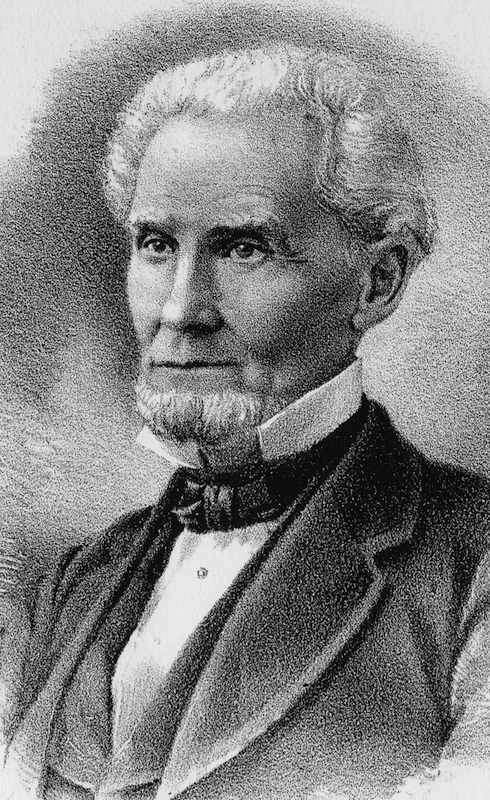Ralston was key in fighting cholera epidemics

Dr. Joseph N. Ralston (1801-76) was born in Kentucky and attended Transylvania University in Lexington.
He arrived in Quincy in 1832 and was one of two doctors during the first recorded cholera epidemic in 1833.
A citizen committee was formed that included Ralston and Dr. Samuel W. Rogers. They met at the courthouse every morning and gathered contributions to feed the sick and bury the dead until the epidemic subsided.
That first epidemic cost 33 lives out of a population of 400.
In the Illinois Bounty Land Register April 17, 1835, Ralston and Dr. Hiram A. Rogers advertised a continuation "of their practice as usual and they have and intend to keep, a general assortment of drugs and medicines for family use, on as good terms as can be had in town."
As was common at the time, the physician office and drugstore were one and the same.
The office was on Maine Street on the west side of the public square. The doctors continued the partnership until 1854.
Henry Asbury told an amusing story in his reminiscences about the first steam ferry brought to Quincy by a Mr. Keyes in 1835.
Ralston and his wife were part of a group who decided to form a party of 50 to travel to LaGrange, Mo., trying out the new mode of travel across the Mississippi River.
Unfortunately, the ferry stopped running, they were stranded most of the night and were set upon by mosquitoes.
The boiler was fixed, and the ferry finally arrived in LaGrange at 2 a.m., traveling at 1 mph.
They woke the only grocery keeper as they were all hungry and returned to Quincy by daybreak, cold, tired and covered with bites.
During Quincy's second major cholera epidemic in 1849, Ralston was attributed with doing much "to stem the tide of the epidemic."
However, like all physicians of the time, he did not think the disease was infectious or contagious.
During this epidemic, river traffic and country trade was suspended, and by the time the epidemic ended, 400 were dead.
The Adams County Medical Society was organized a short time later because the area physicians knew the importance of cooperation to fight epidemics. It is one of the oldest medical societies in Illinois and predates the Illinois State Medical Society. Ralston was its first president.
To be members, physicians had to register their diploma, pay dues and abide by the code of ethics.
Those who had not attended a university and who learned medicine through apprenticeship with another physician were denied membership.
During this time, Ralston was in a partnership with a Dr. Hollowbush, advertising that they would "attend to calls in the country as well as in the city."
He was described as being an "eminently respectable medical practitioner" and "one of the best of citizens."
In addition to his work as a physician, Ralston was involved in community work.
In 1834, he was one of 17 men who founded the Bodley Masonic Lodge in Quincy, the first lodge in Illinois. The installation ceremony was in Ralston's office on Maine Street.
The lodge worked under the Grand Lodge of Kentucky until the Grand Lodge of Illinois was set up in 1840.
Quincy received its first city charter in 1840. A mayor was elected and the city divided into three wards.
Ralston served with John Wood, both Whig candidates, as the first aldermen of the third ward. Always civic minded, he encouraged the City Council to set aside money to build the first public school and was president of the system.
At that time, schooling was not embraced by all citizens. Many objected to children being idle when they could be working and others didn't want tax money used for something they did not value.
One source wrote, "Dr. Ralston, one of the most excellent and exemplary men both in public and private life, that the city ever had, gave to this subject his special interest and attention, bringing the matter continually before the council, where, as with the public, his intelligent and integrity gave him more than an average influence. It was ordered in October, at his recommendation, that the city public schools should be established."
In 1841, he was one of the organizers of the library association and elected its first vice president.
The library opened on April 18, and by the end of the year, it had accumulated 735 volumes.
In 1865, an anonymous group of Ralston's friends gave him a standing-top phaeton carriage. It was manufactured by E.M. Miller & Co. and was placed in his barn with a gift card.
According to The Daily Whig, Ralston was completely surprised and the paper further wrote, "It was a deserved as well as highly flattering compliment to an old and much respected resident of Quincy."
Five years later, a fire broke out in the rear of his kitchen at his home on Maine Street between Third and Fourth. There was a strong southwest wind that drove the fire into the home and to the stores and stables nearby. Before it could be extinguished, it consumed several homes and businesses, including The Quincy Daily Herald building. The Quincy Daily Whig said, "Never has such a terrific fire raged in our midst, and never were more acts of heroism and courage performed under the most trying circumstances than occurred last night." The loss of property was estimated at $300,000.
Ralston remained active in his practice until a year before his death in 1876. His obituary says, "He was a gentleman whom all people respected highly."
Arlis Dittmer is a retired medical librarian. During her 26 years with Blessing Health System, she became interested in medical and nursing history -- both topics frequently overlooked in history.






